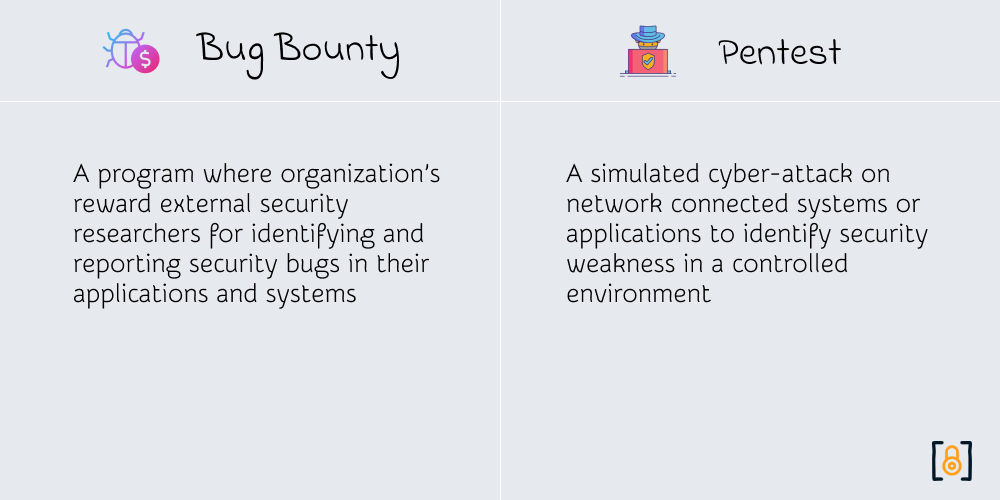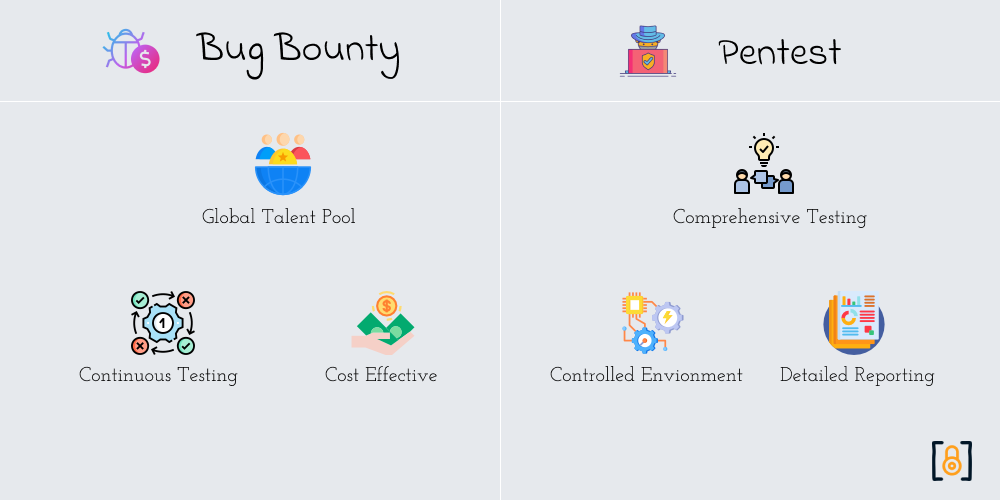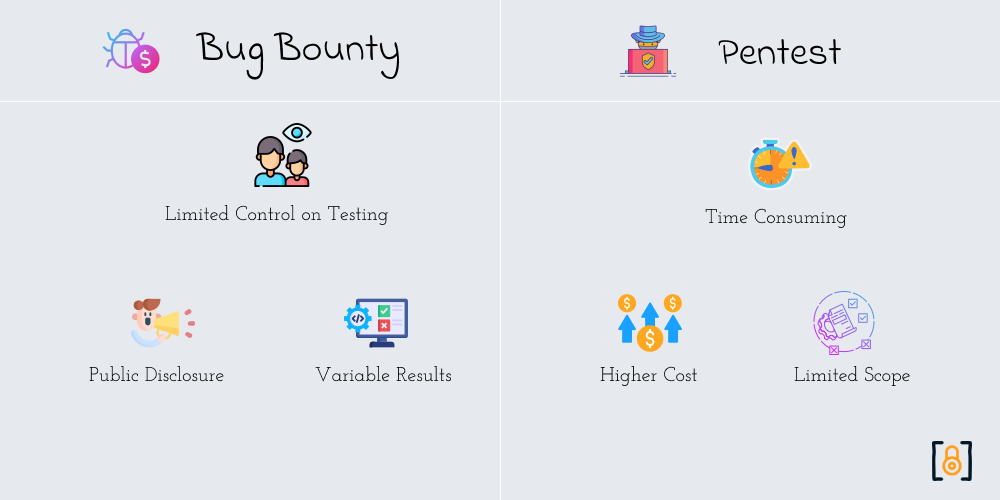Bug Bounty vs Pentest: Making an Informed Decision on Security Testing
Both bug bounty and pentest play crucial roles in identifying and addressing security vulnerabilities, but they differ in their approaches. Understanding these differences helps you choose which type of security testing best suits for organizations or hackers who want to get into security testing.

It looks like you want to know better about what bug bounty is and how it differs from pentest for your security needs. This article will break down the differences, benefits, and drawbacks of each to help you make an informed decision. Whether you're a beginner in security, a project manager, or a security professional, this article will help you choose the right approach for your specific security needs.
Introduction to Bug Bounty and Pentest
In today's digital landscape, where cyber threats constantly evolve, organizations increasingly turn to security testing, and we keep on hearing about the words bug bounty programs and pentests to enhance security measures.
Both bug bounty and pentest play crucial roles in identifying and addressing security vulnerabilities, but they differ in their approaches. Understanding these differences helps you choose which type of security testing best suits for organizations or hackers who want to get into security testing.

Bug Bounty Explained
What is Bug Bounty?
Individual organizations implement a program to reward external security researchers for identifying and reporting security bugs in their applications and systems.
This program helps organizations uncover the security gaps that haven't been considered or missed in their security assessments. Addressing the reported security findings in the early stages helps to strengthen the organization's critical applications and systems before malicious actors exploit them.
Depending on the organization's policies, they even acknowledge and reward the researchers for responsibly disclosing the security flaws in their systems. The rewards might vary, like incentives, hall-of-fame credits, points, s, etc.
This process is also known as crowdsource security testing or Vulnerability Reward Programs (VRPs), which invites all independent security researchers around the world to participate in the program. This approach also enables organizations to tap into a global talent pool of cybersecurity experts and leverage their diverse skill sets to uncover potential security flaws.
How Bug Bounty Programs Work?
1. Organizations define the scope of their bug bounty program, which includes the systems, applications, guidelines, rewards structure, and types of vulnerabilities eligible for rewards.
2. Independent Security Researchers (aka Bug bounty hunters) then conduct security testing within the specified scope and report any discovered vulnerabilities to the organization's security team.
3. Upon successful validation, the security bug is triaged. Post-triaging, the organization rewards the bug bounty hunter according to a predetermined bounty structure.
Remember, if everyone reports the same bug, only the first person to report will receive the bounty.
What are Bug Bounty Platforms?
A central hub that manages multiple organizations' Bug Bounty programs and a pool of bug bounty hunters.
Bug bounty platforms bridge organizations and bug bounty hunters by establishing clear guidelines and policies for researchers, streamlining the vulnerability management process, facilitating efficient communication, timely resolution of reported security issues, and rewarding researchers.
They oversee the entire bug bounty program life cycle, making each party understand their roles and responsibilities in a well-organized and efficient way.
It's a less hindering process for organizations and Security Enthusiasts who are getting started.
Examples: HackerOne, BugCrowd, Intigrity, Github
Refer here for information about more platforms.
Who can start a Bug Bounty program?
Any organization that decides to minimize security risks and secure its digital data from attackers can start a bug bounty program.
Currently, reputed organizations ranging from government entities, e-commerce platforms, software solutions, logistics companies, finance organizations, open-source programs, etc, all run bug bounty programs.
If you ever feel that managing security vulnerabilities is daunting, don't hesitate to utilize Bug Bounty platforms. They are readily available to provide assistance and support.
Bug Bounty programs are instrumental in reducing unknown threats.
Examples: Google Bug Hunters, Meta (aka Facebook), Microsoft
Who can participate in a Bug Bounty program?
Well, there are no hard rules. Anyone with internet access having experience/interest in learning security testing can jump into the program and try it.
The Bug Bounty program is available for different security streams, web applications, mobile applications, binary applications, source code review, IOT, etc. Feel free to choose the one that is of most interest to you.
Key Features of Bug Bounty
- Global Talent Pool: Bug bounty programs allow organizations to access a diverse community of security researchers with varying expertise and perspectives.
- Continuous Testing: Bug bounty programs enable ongoing security testing, as researchers can continuously search for vulnerabilities, providing a proactive approach to security.
- Cost-Effective: Organizations only pay for valid vulnerabilities identified, making bug bounty programs a cost-effective security testing solution.

Pentest Explained
What is Pentest?
Penetration testing, often abbreviated as pentest or pentesting, is a simulated cyber-attack on a computer system, network, or web application to identify security weaknesses. This assessment thoroughly evaluates an organization's IT infrastructure by deliberately attempting to exploit weaknesses in a controlled environment.
Penetration testing is conducted by the organization's internal staff or in collaboration with reputable service providers in the market.
It aims to identify security gaps and provides actionable insights to improve the organization's overall security.
Types of Pentesting
There are various types of penetration testing, including network penetration testing, web application penetration testing, mobile application penetration testing, etc. Each type focuses on specific areas of an organization's IT infrastructure and applications, providing a comprehensive assessment of security vulnerabilities.
Key Features of Pentest
- Comprehensive Testing: Pentesting offers a holistic evaluation of an organization's security posture by simulating real-world attack scenarios across different systems and applications.
- Controlled Environment: Pentests are conducted in a controlled environment, allowing organizations to manage the testing process and minimize potential disruptions to their operations.
- Detailed Reporting: Pentest reports provide in-depth insights into identified vulnerabilities and actionable recommendations to mitigate security risks.
Importance of Security Testing
Both bug bounty programs and penetration testing are crucial components of a comprehensive security strategy. They help organizations proactively identify and address vulnerabilities before malicious actors can exploit them, thereby reducing the risk of a data breach. By conducting security testing, organizations can enhance their overall security posture and build trust with their customers and stakeholders.

Understanding the Differences
Approach and Methodology
Bug bounty programs rely on the collective expertise of a global community of researchers, leveraging their diverse approaches and methodologies to uncover vulnerabilities. In contrast, penetration testing follows a structured methodology and best practices, often tailored to the specific needs and requirements of the organization.
Scope and Coverage
Bug bounty programs offer a broader scope, allowing researchers to test various systems and applications using a wide range of techniques. However, the scope of a penetration test can be customized to focus on specific areas of concern within an organization's IT infrastructure. (Say like test only network devices, mobile applications, biometric devices, etc.)
Cost and Resource Allocation
Bug bounty programs operate on a pay-for-results model, where organizations only pay for valid vulnerabilities identified. On the other hand, penetration testing typically involves upfront costs, time-bound, and resource allocation for engaging a specialized security testing team or service provider.
Scalability
The vulnerability reward program (VRPs) enables organizations to quickly initiate large-scale security testing for their internet-facing applications with limited resources. In contrast, penetration testing requires a substantial team, time, and knowledgeable resources to establish a trusted platform at scale.

Benefits of Bug Bounty
Diverse Skill Set
Bug bounty programs enable organizations to harness the diverse skill sets and perspectives of a global community of security researchers, providing a wide range of expertise in identifying vulnerabilities.
Continuous Testing
Bug bounty programs facilitate ongoing security testing, allowing organizations to identify and address vulnerabilities as new threats emerge continuously.
The moment when a zero-day vulnerability is first known to the community, the bounty hunters would be the first to try it out on organization systems or applications they were working on and raise the security flaw immediately within a few hours. This trend can generally spotted where their incentives are generally high.
Cost-Effective
Bug bounty programs offer a cost-effective approach to security testing, as organizations only pay for valid and unique vulnerabilities identified by researchers.
Researchers Verification
Some organizations that host bounty programs under the managed Bug Bounty platforms even request to verify the details of the security researchers before allowing them into the bug bounty program. This is an additional measure taken care of by the platforms themselves and helps to build trust.
Benefits of Pentest
Comprehensive Testing
Penetration testing provides a comprehensive evaluation of an organization's security posture, identifying vulnerabilities across different systems and applications.
Generally, penetration testing is carried out either by the organization's internal security team or by the external service provider to secure the business's critical assets from external attackers.
When an internal team performs pen-testing, they might have access to the application architecture diagrams, documentation, development team support, and source code to provide extensive coverage.
Every possibility of security risk identified is documented, from low severity to high-severity issues in the applications or in network-connected devices. Based on risk assessment, impactful security vulnerabilities are addressed as a priority.
Controlled Environment
Pentests are conducted in a controlled environment, allowing organizations to manage the testing process and minimize potential disruptions to their operations.
In some cases, penetration testing is performed on non-production environments to minimize the impact on customers, which would be an exact replica of what would be going into production.
All the security assessments are carried out in stages and segregated into specific groups like network security, web security, mobile security, etc.
Detailed Reporting
Pentest reports offer detailed insights into identified vulnerabilities, along with actionable recommendations to strengthen the organization's security defenses.
Business stakeholders review and direct the teams to take action to minimize the security risks, ranging from high-impact to low-impact business risks. Also, monitor the security health of their organization.
Overall, the organization's security posture will be known with this approach.
Compliances and Best Practices
Penetration testing is also essential for meeting industry regulations, best practices, and standards. Based on the data criticality, it must be carried out at regular intervals.

Drawbacks of Bug Bounty
Limited Control
Organizations have limited control over the testing process in bug bounty programs, as researchers operate independently and may or may not adhere to specific testing guidelines.
In Bug bounty programs, even though organizations define a detailed scope of requirements of what is allowed and what is not, like using automated tools or looking out for specific categories of vulnerabilities as part of security testing, it depends on individual security researchers.
Bug bounty hunters are even banned or removed from the program in case of deviations from the given scope.
Public Disclosure of Vulnerabilities
Poorly managed Bug bounty programs may lead to public disclosure of vulnerabilities, potentially impacting an organization's reputation.
In bug bounty hunting, a researcher must report a vulnerability and has to wait for a duration, say 60-90 days, for acknowledgment. Upon not receiving any communication from the organization for the given time frame, a researcher might disclose the bug publicly. This generally happens only in the case of an ineffective program.
Variable Results
The effectiveness of bug bounty programs can vary, as the identification of vulnerabilities depends on the skills and motivations of participating researchers.
The participating researchers are from a wide pool of knowledge backgrounds. It can be a security researcher, a software developer interested in security, a passionate system administrator, a college student interested in bug bounties, etc.
Bug bounty hunters, in some cases, focus only on a single target, which gives them higher chances of finding a bug by carefully monitoring the changes and immediately reporting the misconfigured ones.
On the other hand, some bounty hunters only take one category of vulnerability and keep reporting it in each application whenever they find it.
All the approach varies based on the perspective of the bug bounty hunter.
Drawbacks of Pentest
Time-Consuming
Penetration testing can be time-consuming, especially for comprehensive assessments that cover multiple systems and applications within an organization's IT infrastructure.
It requires multiple parties to be involved, allocating resources, and shorter time intervals might be provided when in a hurry for production releases.
Limited Scope
The scope of a penetration test may be limited based on the specific areas of concern identified by the organization, potentially overlooking vulnerabilities in other areas.
Higher Cost
Engaging in penetration testing typically involves higher upfront costs and resource allocation compared to bug bounty programs.

Making an Informed Decision
Assess Your Security Needs
Organizations should assess their specific security needs by considering factors such as the complexity of their IT infrastructure, the sensitivity of their data being maintained, and the potential impact of security vulnerabilities.
Considering Budget and Resources
Budgetary constraints and the availability of a security skillset play a significant role in determining whether bug bounty programs or penetration testing is a more viable security testing solution for an organization.
Evaluating Long-Term Goals
Organizations should consider their long-term security goals and the level of control they require over the security testing process when choosing between bug bounty programs and penetration testing.
For Bug Bounty Hunters
Whether you want to learn Bug Bounty or Penetration testing, penetration testing is much rewarded for building a professional career. If you would like to do some side hustle and earn some extra bucks, Bug Bounty might be the best choice. Rarely, a few hackers built a career from Bug Bounty, but it requires patience and time and has a very steep learning curve.

Conclusion
In summary, bug bounty programs and penetration tests each offer unique benefits and drawbacks, catering to different security needs.
Organizations, by carefully evaluating the differences and considering specific requirements like the scope of testing, the level of control required, and the budgetary constraints, determine the most suitable approach for addressing security vulnerabilities, which can help to enhance your security posture effectively.
For Bug Bounty hunters, consider your skill set and the time available to choose the one that suits you best. Both required similar skill sets, but the approaches and efforts vary.
In the ever-evolving cybersecurity landscape, one must adapt to changing security testing strategies to mitigate risks and protect digital assets effectively. Whether through bug bounty programs, penetration testing, or a combination of both, proactive security testing is essential for safeguarding against potential threats and maintaining a robust security posture.
